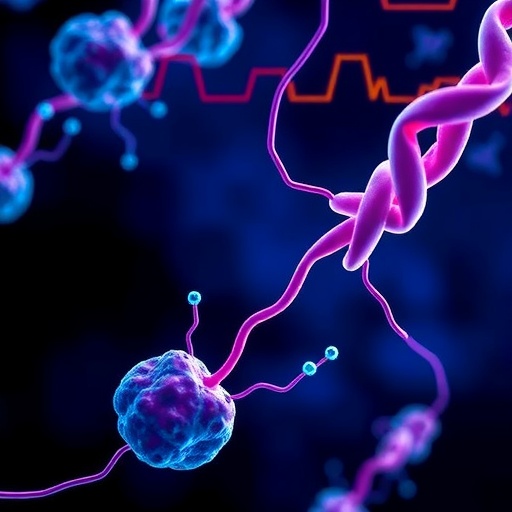In the ever-evolving battle against cancer, one of the most formidable challenges continues to be drug resistance, which severely limits the efficacy of chemotherapeutic agents such as cisplatin. Recent groundbreaking research has illuminated the intricate network of signaling pathways that orchestrate cisplatin resistance in tumor cells, with a particular emphasis on the transcription factor SOX2. This revelation paves the way for novel therapeutic strategies that aim to dismantle the molecular defenses cancer cells erect against treatment.
Cisplatin, a platinum-based chemotherapeutic, has been a mainstay in cancer treatment for decades due to its capability to induce DNA damage and trigger apoptosis in rapidly dividing cells. Despite its potent efficacy, the occurrence of intrinsic or acquired resistance within tumor cells significantly undermines clinical outcomes, leading to treatment failure and disease relapse. Understanding the molecular underpinnings of this resistance has been a central focus of oncological research, with recent studies highlighting the pivotal role of cellular signaling cascades.
Central to the newly uncovered resistance mechanisms is SOX2, a transcription factor traditionally famed for its role in maintaining stemness and cellular plasticity. Tumor cells hijack this pathway, upregulating SOX2 to facilitate survival despite the DNA insults inflicted by cisplatin. This overexpression not only promotes cellular resilience but also enhances repair mechanisms and alters apoptotic thresholds, effectively enabling tumor persistence in hostile chemotherapeutic environments.
The regulation of SOX2 expression is governed by a confluence of signaling pathways that collectively modulate tumor cell behavior. Key among these are the PI3K/AKT/mTOR, Wnt/β-catenin, and NF-κB pathways, each serving as a critical conduit for signals that dictate cell proliferation, survival, and differentiation. Dysregulation of these pathways can amplify SOX2 activity, thereby bolstering the tumor’s defensive arsenal against cisplatin.
The PI3K/AKT/mTOR axis is renowned for its role in promoting cell survival and growth, making it a prime suspect in the molecular landscape of chemoresistance. Activation of this pathway results in enhanced SOX2 transcription, augmenting the tumor’s capability to repair cisplatin-induced DNA damage. Moreover, this axis inhibits pro-apoptotic factors, tipping the balance in favor of tumor cell survival even under genotoxic stress.
Meanwhile, the Wnt/β-catenin signaling cascade operates as a master regulator of cell fate and proliferation. Aberrant activation of Wnt signaling has been demonstrated to stabilize β-catenin, facilitating its translocation to the nucleus where it drives SOX2 expression. This not only perpetuates stem-like qualities in cancer cells but also enhances their adaptive response to cisplatin, allowing for persistent growth and invasion.
The NF-κB pathway, a well-known mediator of inflammation and cell survival, has also been implicated in upregulating SOX2 in resistant tumor populations. Chronic activation of NF-κB signaling fosters an environment conducive to chemoresistance by inducing anti-apoptotic genes and sustaining the transcription of resistance-related factors like SOX2. This interplay exemplifies how inflammatory signaling can be co-opted to shield tumor cells from chemotherapy-induced apoptosis.
The consequences of SOX2 upregulation extend beyond mere survival; it orchestrates a broad transcriptional program that supports epithelial-mesenchymal transition (EMT), enhances cellular plasticity, and promotes metastatic potential. These features collectively contribute to the aggressive phenotype of cisplatin-resistant tumors and highlight the multifaceted role of SOX2 in cancer progression.
Adding another layer of complexity, extracellular vesicles (EVs) released by tumor cells have been shown to carry SOX2 mRNA and proteins, facilitating intercellular communication that spreads resistance traits within the tumor microenvironment. This EV-mediated transfer not only amplifies resistance within heterogeneous tumor populations but also establishes a pro-survival niche that dampens cisplatin efficacy.
Furthermore, epigenetic modifications such as histone acetylation and DNA methylation patterns have been observed to modulate the accessibility of the SOX2 gene locus, influencing its expression in response to chemotherapeutic stress. These reversible changes underscore the plasticity of resistance mechanisms and highlight potential avenues for epigenetic therapy to re-sensitize tumors to cisplatin.
Targeting the signaling pathways that regulate SOX2 presents a promising therapeutic frontier. Inhibitors of PI3K/AKT/mTOR, Wnt/β-catenin, and NF-κB pathways are currently under investigation, with preclinical studies showing that their combination with cisplatin can significantly restore drug sensitivity. This combinatorial approach holds potential not only for overcoming resistance but also for curbing tumor recurrence.
Moreover, advancements in CRISPR/Cas9 genome editing have enabled precise manipulation of SOX2 expression in tumor cells, offering proof-of-concept that downregulating this factor can impair resistance and enhance cisplatin-induced cytotoxicity. This genetic approach serves as a powerful tool to dissect resistance networks and develop tailored interventions.
The clinical implications of these findings are profound. Biomarker assays detecting SOX2 levels and the activity of associated signaling pathways could guide personalized treatment regimens, ensuring patients receive therapies that circumvent or counteract resistance. This stratification promises to increase response rates and improve survival outcomes in cancers traditionally refractory to cisplatin.
Despite these advances, challenges remain in translating this molecular knowledge into effective therapies. The redundancy and crosstalk among signaling pathways necessitate combination treatments that are meticulously calibrated to minimize toxicity while maximizing tumor suppression. The heterogeneity of tumor microenvironments further complicates this endeavor, requiring adaptive and dynamic treatment strategies.
Looking forward, integrative approaches combining pharmaceuticals that target SOX2 regulatory networks with immunotherapies and nanotechnology-based drug delivery systems may revolutionize cancer treatment paradigms. Such multifaceted interventions could dismantle the tumor’s resistance machinery from multiple fronts, ushering a new era of precision oncology.
In conclusion, the elucidation of signaling pathways that govern SOX2 upregulation marks a significant milestone in understanding cisplatin resistance. This research not only exposes the molecular intricacies that shield tumors from chemotherapy but also directs innovative strategies to surmount one of oncology’s most persistent obstacles. As scientific knowledge converges with technological innovation, hope grows for more durable and effective cancer therapies in the near future.
Subject of Research: Mechanisms of cisplatin resistance in tumor cells mediated by signaling pathways regulating SOX2 expression.
Article Title: Signaling pathways as the pivotal regulators of cisplatin resistance in tumor cells through SOX2 upregulation.
Article References:
Taghehchian, N., Akhlaghipour, I., Zangouei, A.S. et al. Signaling pathways as the pivotal regulators of cisplatin resistance in tumor cells through SOX2 upregulation. Med Oncol 42, 437 (2025). https://doi.org/10.1007/s12032-025-03004-9
Image Credits: AI Generated




